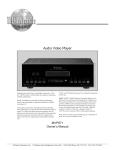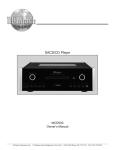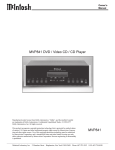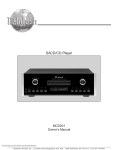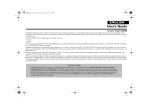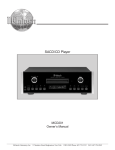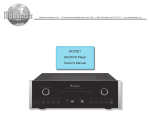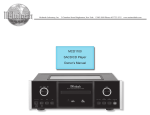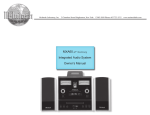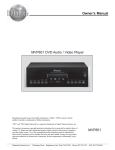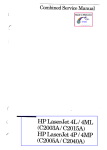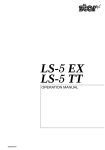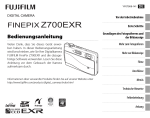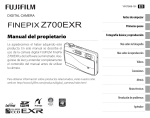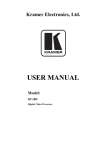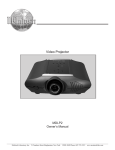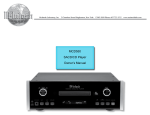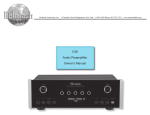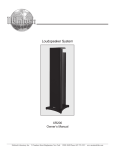Download McIntosh MVP881
Transcript
McIntosh Laboratory, Inc. 2 Chambers Street Binghamton, New York MVP881BR Audio Video Player Owner’s Manual 13903-2699 Phone: 607-723-3512 www.mcintoshlabs.com The lightning flash with arrowhead, within an equilateral triangle, is intended to alert the user to the presence of uninsulated “dangerous voltage” within the product’s enclosure that may be of sufficient magnitude to constitute a risk of electric shock to persons. WARNING - TO REDUCE RISK OF FIRE OR ELECTRICAL SHOCK, DO NOT EXPOSE THIS EQUIPMENT TO RAIN OR MOISTURE. CAUTION - Invisible Laser Radiation when open. DO NOT stare into the beam or view directly with optical instruments. Use of controls or adjustments or performance of procedures other than those specified in the Owners Manual may result in Hazardous Radiation Exposure. LUOKAN 1 LASERLAITE KLASS 1 LASER APPARAT VAROITUS! VARNING! Laitteen kayttaminen muulla kuin tassa kayttoohjeessa mainitulla tavalla saattaa altistaa kayttajan turvallisuusluokan 1 ylittavalle nakymattomalle lasersateiiylle. Om apparaten anvands pa annat satt an i denna bruksanvisning specificerats, kan anvandaren utsattas for osynbg laserstraining, som overskrider gransen for laserklass 1. This product incorporates an embedded CLASS 3R Laser (IEC60825-1). 2 The exclamation point within an equilateral triangle is intended to alert the user to the presence of important operating and maintenance (servicing) instructions in the literature accompanying the appliance. NO USER-SERVICEABLE PARTS INSIDE. REFER SERVICING TO QUALIFIED PERSONNEL. To prevent the risk of electric shock, do not remove cover or back. No user-serviceable parts inside. IMPORTANT SAFETY INSTRUCTIONS! PLEASE READ THEM BEFORE OPERATING THIS EQUIPMENT. 1. Read these instructions. 2. Keep these instructions. 3. Heed all warnings. 4. Follow all instructions. 5. Do not use this apparatus near water. 6. Clean only with a dry cloth. 7. Do not block any ventilation openings. Install in accordance with the manufacturer’s instructions. 8. Do not install near any heat sources such as radiators, heat registers, stoves, or other apparatus (including amplifiers) that produce heat. 9. Do not defeat the safety purpose of the polarized or grounding-type plug. A polarized plug has two blades with one wider than the other. A grounding type plug has two blades and a third grounding prong. The wide blade or the third prong are provided for your safety. If the provided plug does not fit into your outlet, consult an electrician for replacement of the obsolete outlet. 10. Protect the power cord from being walked on or pinched particularly at plugs, convenience receptacles, and the point where they exit from the apparatus. 11. Only use attachments/accessories specified by the manufacturer. 12. Use only with the cart, stand, tripod, bracket, or table specified by the manufacturer, or sold with the apparatus. When a cart is used, use caution when moving the cart/ apparatus combination to avoid injury from tip-over. 13. Unplug this apparatus during lightning storms or when unused for long periods of time. 14. Refer all servicing to qualified service personnel. Servicing is required when the apparatus has been damaged in any way, such as powersupply cord or plug is damaged, liquid has been spilled or objects have fallen into the apparatus, the apparatus has been exposed to rain or moisture, does not operate normally, or has been dropped. 15. Do not expose this equipment to dripping or splashing and ensure that no objects filled with liquids, such as vases, are placed on the equipment. 16. To completely disconnect this equipment from the a.c. mains, disconnect the power supply cord plug from the a.c. receptacle. 17. The mains plug of the power supply cord shall remain readily operable. 18. Do not expose batteries to excessive heat such as sunshine, fire or the like. 19. Connect mains power supply cord only to a mains socket outlet with a protective earthing connection. 20. Warning: The Ethernet connector of this equipment must not be directly connected to a public network. Connection is to be made only by way of a modem or router approved for this purpose. 3 Trademark and License Information Trademark and License Information The McIntosh MVP881BR incorporates copyright protection technology that is protected by U.S. patents and other intellectual property rights. Use of this copyright protection technology must be authorized by Macrovision, and is intended for home and other Trademark Logo limited viewing uses only unless otherwise authorized by Macrovision. Reverse engineering or disassembly is prohibited. The MVP881BR uses the following Technologies: License Information Blu-ray Disc and “ ” are trademarks. is a trademark of the DVD Format /Logo licensing Corporation. TM HIGH-DEFINITION MULTIMEDIA INTERFACE 4 HDMI, the HDMI logo and High- Definition Multimedia Interface are trademarks or registered trademarks of HDMI Licensing LLC. Java and all other trademarks and logos are trademarks or registered trademarks of Sun Microsystems, Inc. in the United States and/or other countries. Manufactured under license from Dolby Laboratories. Dolby, Pro Logic and the double-D symbol are trademarks of Dolby Laboratories. Manufactured under license under U.S. Patent #’s: 5,451,942; 5,956,674; 5,974,380; 5,978,762; 6,226,616; 6,487,535; 7,212,872; 7,333,929; 7,392,195; 7,272,567 & other U.S. and worldwide patents issued & pending. DTS is a registered trademark and the DTS logos, Symbol, DTS-HD and DTS-HD Master Audio are trademarks of DTS, Inc.© 1996-2008 DTS, Inc. All Rights Reserved. Trademark Logo License Information Windows Media and the Windows logo are trademarks or registered trademarks of Microsoft Corporation in the United States and/or other countries. , HDCD®, High Definition Compatible Digital® and Microsoft® are either registered trademarks or trademarks of Microsoft Corporation, Inc. in the United States and/or other countries. HDCD system manufactured under license from Microsoft Corporation, Inc. This product is covered by one or more of the following: In the USA: 5,479,168, 5,638,074, 5,640,161, 5,808,574, 5,838,274, 5,854,600, 5,864,311, 5,872,531, and in Australia: 669114. Other patents pending. “AVCHD” and “AVCHD” logo is the trademark of Panasonic Corporation and Sony Corporation. “BONUSVIEW” is the trademark of Blu-ray Disc Association. “BD-LIVE” logo is trademark of Blu-ray Disc Association. Thank You Customer Service Your decision to own this McIntosh MVP881BR Audio Video Player ranks you at the very top among discriminating music listeners. You now have “The Best.” The McIntosh dedication to “Quality,” is assurance that you will receive many years of visual and musical enjoyment from this unit. Please take a short time to read the information in this manual. We want you to be as familiar as possible with all the features and functions of your new McIntosh. If it is determined that your McIntosh product is in need of repair, you can return it to your Dealer. You can also return it to the McIntosh Laboratory Service Department. For assistance on factory repair return procedure, contact the McIntosh Service Department at: Please Take A Moment The serial number, purchase date and McIntosh Dealer name are important to you for possible insurance claim or future service. The spaces below have been provided for you to record that information: Serial Number:_______________________________ Purchase Date:_ ______________________________ Dealer Name:_ _______________________________ Technical Assistance If at any time you have questions about your McIntosh product, contact your McIntosh Dealer who is familiar with your McIntosh equipment and any other brands that may be part of your system. If you or your Dealer wish additional help concerning a suspected problem, you can receive technical assistance for all McIntosh products at: McIntosh Laboratory, Inc. 2 Chambers Street Binghamton, New York 13903 Phone: 607-723-1545 Fax: 607-724-0549 McIntosh Laboratory, Inc. 2 Chambers Street Binghamton, New York 13903 Phone: 607-723-3515 Fax: 607-723-1917 Table of Contents Safety Instructions................................................... 2-3 Trademark and License Information.......................... 4 Thank You and Please Take a Moment....................... 5 Technical Assistance and Customer Service.............. 5 Table of Contents........................................................ 5 General Information................................................... 6 SD Card Information.................................................. 6 Disc Information......................................................... 7 Connector and Cable Information.............................. 7 Introduction................................................................. 8 Performance Features................................................. 8 Dimensions................................................................. 9 Installation.................................................................10 Front Panel Features: Front Panel Displays, Push-buttons and SD Card Slot........................................................16 Front Panel Information Display................................17 Setup: Introduction to the MVP881BR Setup Mode.......18-20 Default Settings.........................................................21 Language and HDMI Setup................................. 22-23 Video and Audio Setup . ..................................... 23-25 Ratings, Network, Display and Other Setup........ 26-27 Operation: How to Operate MVP881BR............................... 28-33 MVP881BR Audio/Video Settings and Adjustments.................................................. 34-37 Firmware Update................................................. 38-40 Additional Information: Specifications.............................................................42 Packing Instruction....................................................43 Connections: Rear Panel Connectors...............................................11 Making Connections..................................................12 Remote Control: Remote Control Push-buttons....................................14 How to Use the Remote Control................................15 Copyright 2010 © by McIntosh Laboratory, Inc. 5 General and SD Card Information General Information 1. For additional connection information, refer to the owner’s manual(s) for any component(s) connected to the MVP881BR Audio Video Player. 2. If the MVP881BR will be connected to a TV/ Monitor using the Component Video connections, please refer to “Setup Mode” on page 23 for additional information. 3. The Super Audio Compact Discs (SACD) Audio Signals are converted internally from Digital to Analog. 4. A PCM version of the decoded MP3 Signal is available at the Digital Audio Outputs. 5. The MVP881BR has built-in 192kHz 32-Bit DACs (Digital to Analog Converter) to allow playing of Discs recorded with a higher bit and sample rate, by using the Analog Audio Outputs. 6. Some Multichannel BD (Blu-ray), DVD, DVDVideo, DVD-Audio and Super Audio Compact Discs might contain Low Frequency Audio Signals (below 80Hz) in the Center and/or Surround Channels. If the Loudspeakers in your sound system are not capable of reproducing those Low Frequencies, distortion and/or possible damage to the Loudspeakers may occur. For additional information, consult with your Dealer or refer to the Owner’s Manual for your Loudspeakers. 7. The DVD-Audio and Super Audio Compact Discs Digital Audio Signal is available via the HDMI Output. The MVP881BR also internally decodes the Digital Audio from DVD-Audio and Super Audio Compact Disc and the Eight Channel Analog Signals are available at the UNBALANCED AUDIO OUTPUTS (7.1CH). 6 8. HDMI Cable lengths between MVP881BR and the Audio/Video Control Center should not exceed 25ft (8.3meters). If there is need to use HDMI Cables longer than 25ft (8.3meters) a high quality in line HDMI Buffer/Converter would be required for reliable digital signal transmission via the HDMI Connections. 9. The MVP881BR basic transport functions may also be controlled by using other McIntosh Remote Controls or Keypads thru a McIntosh Control Center or Preamplifier. Refer to the owner’s manual(s) supplied with those component(s) for additional operation information. 10. PCM (Pulse Code Modulation) is the name given to a specific type of Digital Audio Signal. The CD Audio Disc and the supplemental audio track found on some Blu-ray Discs use the PCM format. 11. Sound Intensity is measured in units called Decibels and “dB” is the abbreviation. 12. When discarding the unit, comply with local rules or regulations. Batteries should never be thrown away or incinerated but disposed of in accordance with the local regulations concerning battery disposal. 13. For additional information on the MVP881BR and other McIntosh Products please visit the McIntosh Web Site at www.mcintoshlabs.com. SD Card Information The MVP881BR has a Front Panel Slot for accepting SD (Secure Digital) Memory Cards. The SD Card is used in BD-Live and Bonus View Mode. The SD Card provides the memory storage needed for the additional program content which is downloaded from the Movie Studio/Record Company via the MVP881BR internet connection. It may also be used for playback of Audio and Video Files. 1. Before switching On the MVP881BR, the SD/ SDHC Card must be inserted into the Front Panel Slot. 2. Do not remove an SD Memory Card or switch off the MVP881BR while the card content is in playback. This could result in malfunction or loss of the card’s data. 3. Additional SD/SDHC Cards used need to have a storage capacity of 1GB (Gigabit) or greater. 4. A Mini SD/SDHC Card or Micro SD/SDHC Card plugged into a SD Adapter may also be used with the MVP881BR. 5. Before using the SD Card for storage or playback in the MVP881BR, it first must be initialized (formated) using the MVP881BR built-in initializing function. Refer to SETUP Mode starting on page 18 for additional information. 6. SDHC Cards need to be formated for the FAT32 File System before use with MVP881BR. 7. The MVP881BR will display Photos in the JPEG File Format from a SD/SDHC Card. 8. Read and follow all instructions provided by the SD Memory Card manufacturer to prevent damage to the Card and to the files contained on the Card. Disc Information, Connector and Cable Information Disc Information 1. Compact Discs that are not round (e.g. Novelty discs with octagonal or heart shapes) will not play properly in the MVP881BR and should not be tried, as possible damage may occur. 2. The MVP881BR Audio Video Player is designed to play all standard CD Audio Discs that conform to the Official Compact Disc Standards which is indicated by the Symbol . 3. The MVP881BR will play most of the following discs, however some recorded discs may not be able to play due to the condition of the recording: BD-Video, Super Audio CD (SACD), HDCD, CD-R, CD-RW, Picture CD (Kodak), Fujicolor CD, WMA(Windows), DVD-Audio, DVD-Video, DVD-R, DVD+R, DVD-RW, DVD+RW, and DVD-AVCHD. 4. CD Audio Discs recorded in the MP3, WMA, AAC or LPCM Format will playback on the MVP881BR except discs that contain multi-session recordings. 5. The MVP881BR will display Photos in the JPEG File Format from a Disc. 6. The CD audio side of the Dual Disc does not meet the Compact Disc Digital Audio specifications found in the industry “Redbook”; the MVP881BR may not read the CD side of a Dual Disc. 7. Several of the DVD, DVD-Audio and SACD performance features available on the MVP881BR are active only if the Disc includes the supporting encoded information. 8. BD-Video and DVD-Video Discs are designed to only play in certain region(s) of the world. A region may be a single country or a group of countries. Usually on the back cover of the Video Disc container is a Symbol with either a “Character” or “Number(s)” or the word “All” inside it. The Connector and Cable Information MVP881BR is designed to play discs for Regions “A”, “1” and “All”. 9. Certain Dolby Digital and DTS Encoded Discs display their own unique Audio Mode Selection menu, every time the disc is loaded into the player. If you do not make a choice from this menu, the disc will revert to its default Audio Mode when play is started. XLR Connectors Below is the Pin configuration for the XLR Balanced Output Connectors on the MVP881BR. Refer to the diagram for connection: PIN 1: Shield/Ground PIN 2: + Output PIN 1 PIN 2 PIN 3: - Output PIN 3 Power Control Connector The MVP881BR Power Control Input/Output Jacks receive/send Power On/Off Signals Power Control when connected to other McIntosh N/C Components. A 1/8 inch stereo mini Ground phone plug is used for connection to the Power Control Input/Output on the MVP881BR. Note: The Data ad Power Control Connecting Cable is available from the McIntosh Parts Department: Data and Power Control Cable Part No. 170-202 Six foot, shielded 2 conductor, with 1/8 inch stereo mini phone plugs on each end. Data and IR Input Port Connectors The MVP881BR Data In Port receives Remote Control Signals. A 1/8 inch stereo mini phone plug is used for connection. The IR Ports also use a 1/8 inch stereo mini phone plug and allow the connection of other brand IR Receivers to the MVP881BR. RS232 DB9 Connector Pin Layout 1. N/C 6. N/C 2. Data Out (TXD) 7. N/C 3. Data In (RXD) 8. N/C 4. N/C 9. N/C 5. Gnd. Data Signal N/C Data Ground IR Data Control N/C Ground 7 Introduction and Performance Features Introduction The McIntosh MVP881BR Audio Video Player offers the latest in audio/video technology, providing state of the art reproduction of digital video and audio program sources. A full complement of performance features allows for the enjoyment of Blu-rays, DVDs, SACD, DVD Audio, Audio CDs, special audio and special video formats, all reproduced with flawless realism. The advanced mechanical design of the transport ensures many years of smooth trouble free operation. Performance Features • Triple Laser Pickup The MVP881BR incorporates three laser elements, with different wavelengths, that are focused through one lens assembly. This unique design allows reading many different types of Audio and Video Disc Formats. • Advanced Transport The MVP881BR has a new vibration-resistant Transport housed in a Zinc Die-Cast with an advanced digital servo for faster, quieter and accurate operation. The Video Disc Data is read into memory from the disc at twice the normal rate. Likewise, CD Audio Data is read into memory at four times the normal rate. The fast read speeds help to insure better disc tracking and error correction processing. • 1080p/24frame Video Output The MVP881BR has the highest video resolution available, 1080p/24frames per second image quality via the HDMI Video Output. • Multiple Video Outputs Along with the HDMI (version 1.3a) Video Output the 8 MVP881BR also has Component Video, S-Video and Composite Video Outputs for a variety of applications. Disc Signals and effect the multichannel analog audio outputs. • Advanced Video Circuitry The MVP881BR uses the HQV Realta Processor from Silicon Optix for video deinterlacing, processing and scaling. Digital Noise Reduction and 14/12Bit Digital to Analog Video Conversion for High Definition and Standard Definition Signals. • Power Control The Power Control Input connection provides convenient Turn-On/Off of the MVP881BR when connected to a McIntosh System with Power Control. • 32 Bit Audio DAC The MVP881BR has five two channel Digital to Analog Converters capable of sampling rates up to 192kHz with 32 Bits of resolution. • Balanced Outputs The MVP881BR has Balanced Outputs for the Left and Right Channels when playing a CD/SACD. When a Multichannel Disc is playing, the Balanced Left and Right Outputs provide a two channel mix down of the Multichannel Recording. • Remote Control The Remote Control with illuminated push-buttons, provides control of the MVP881BR operating functions. A Data Port Connection to a McIntosh A/V Control Center or Preamplifier allows for convenient system operation using one Remote Control. An External IR Sensor Input allows for remote operation when the MVP881BR is located behind closed doors. • Special Power Supply A fully regulated Power Supply, with a special R-Core Power Transformer, ensures stable noise free operation even though the power line varies. • Built-in Dolby True HD and DTS-DH Master Decoders The MVP881BR also provides built-in decoding of the Dolby Pro Logic IIx and DTS Neo6 Sound Tracks. • Extruded Side Panels The sides of the MVP881BR are extruded aluminum panels with a bead blast textured surface and a black anodized finish. • Digital Audio Outputs There are HDMI, Coaxial and Optical Digital Audio Outputs for external decoding of the various Dolby Digital, DTS Digital Signals, PCM or MP3 Signals from CDs. • Fiber Optic Solid State Front Panel Illumination The Illumination of the Glass Front Panel is accomplished by the combination of custom designed Fiber Optic Light Diffusers and extra long life Light Emitting Diodes (LEDs). This provides even Front Panel Illumination and is designed to ensure the pristine beauty of the MVP881BR will be retained for many years. • On Screen Setup and Calibration Level and Time Delay Adjustments are available for Dolby Digital, DTS Digital, DVD-Audio and SACD Dimensions Dimensions The following dimensions can assist in determining the best location for your MVP881BR. There is additional information on the next page pertaining to installing the MVP881BR into cabinets. Front View of the MVP881BR 17-1/2" 44.45cm 5-3/8" 13.69cm 6" 15.24cm Side View of the MVP881BR 15-7/8" 40.32cm 14-1/2" 36.83cm 3/16" 0.48cm Rear View of the MVP881BR 4-13/16" 12.22cm 13/16" 2.06cm 17" 2" 43.18cm 5.08cm 10-9/16" 26.83cm 1-15/16" 4.92cm 4-5/8" 11.75cm 13-1/4" 33.65cm 9 Installation Installation The MVP881BR can be placed upright on a table or shelf, standing on its four feet. It also can be custom installed in a piece of furniture or cabinet of your choice. The four feet may be removed from the bottom of the MVP881BR when it is custom installed as outlined below. The four feet together with the mounting screws should be retained for possible future use if the MVP881BR is removed from the custom installation and used free standing. The required panel cutout, ventilation cutout and unit dimensions are shown. Always provide adequate ventilation for your MVP881BR. Cool operation ensures the longest possible operating life for any electronic instrument. Do not install the MVP881BR directly above a heat generating component such as a high powered amplifier. If all the components are installed in a single cabinet, a quiet running ventilation fan can be a definite asset in maintaining all the system components at the coolest possible operating temperature. A custom cabinet installation should provide the following minimum spacing dimensions for cool operation. Allow at least 6 inches (15.24cm) above the top, 2 inches (5.08cm) below the bottom, 3 inches (7.62cm) behind the rear panel and 2 inch (5.08cm) on each side of the Audio Video Player, so that airflow is not obstructed. Do not block the ventilation holes on the top and bottom cover; also do not block the rear panel fan opening. Allow 1 inch (2.54 cm) in front of the mounting panel for clearance. When the DISC Tray is opened, the panel clearance required in front of mounting panel is 6-3/4 inches (17.2cm). Be sure to cut out a ventilation hole in the mounting shelf according to the dimensions in the drawing. 17-1/16" 43.34cm Opening Openingfor forVentilation Ventilation 10-7/8" 27.62cm MVP881BR Front Panel Custom Cabinet Cutout Cabinet Front Panel Cutout Opening for Custom Mounting Cabinet Front Panel Opening for Ventilation MVP881BR Side View in Custom Cabinet Cutout Opening for Ventilation Support Shelf 1" MVP881BR Bottom View in Custom Cabinet 2.54cm Chassis Spacers 1-1/16" 2.70cm 11-1/2" 29.21cm 14" 35.56cm Cutout Opening for Ventilation 2-1/2" 6.35cm Note: Center the cutout Horizontally on the unit. For purposes of clarity, the above illustration is not drawn to scale. 10 6" 15.24cm 12-5/16" 31.27cm 15-1/16" 38.26cm Rear Panel Connectors UNBALANCED AUDIO OUTPUTS supply Seven Channels of analog audio and connects to the External Input of an A/V Control Center VIDEO OUTput supplies video signals to connect to a Composite Input of an A/V Control Center or other video component S-VIDEO OUTput supplies video signals to a S Input of an A/V Control Center or other video component Y OUTPUT connects to the Y Component Input of the TV/Monitor or other video component. PB/CB OUTPUT connects to the PB/CB Component Input of the TV/Monitor or other video component. PR /CR OUTPUT connects to the PR /CR Component Input of the TV/Monitor or other video component HDMI OUT 1 and OUT 2 supplies digital video and digital audio signals to an Input of an A/V Control Center or other audio/video component DATA IN receives UNBALANCED RS-232C connector OPTICAL and COAXIAL operating data AUDIO OUTPUTS for connection to DIGITAL AUDIO OUTfrom a McIntosh supply Two Channels a remote control PUTS send signals to a Control Center of Analog Audio and device Control Center with a D/A connects to the Analog Converter or a decoder Input of an A/V Con- BALANCED IR INput for POWER CONTROL IN ETHERNET trol Center AUDIO OUTPUTS connecting an receives turn-on signals from Network Connector supply two channels IR Receiver a McIntosh component and for connecting the of analog audio to POWER CONTROL OUT MVP881BR to a connect to Balanced sends turn-on signals on to Broadband Ethernet Inputs of other comanother McIntosh Component Network ponents Connect the MVP881BR power cord to a live AC outlet. Refer to information on the back panel of your MVP881BR to determine the correct voltage for your unit 11 Making Connections Making Connections The MVP881BR has the ability to be remotely switched On/Off from a McIntosh Preamplifier or A/V Control Center via the Power Control connection. The MVP881BR Data Port Connection allows for the remote operation of basic functions using the A/V Control Center Remote Control. With an external sensor connected to the MVP881BR, remote control operation is possible from another room and/or when the MVP881BR is located in a cabinet with the doors closed. The connection instructions below, together with the MVP881BR Connection Diagram located on the separate folded sheet “Mc1A, is an example of an audio/video system. Your system may vary from this, however the actual components would be connected in a similar manner. For additional information refer to “Connector and Cable Information” on page 7. Power Control Connections: 1. Connect a Control Cable from the A/V Control Center PC (Power Control) Jack to the POWER CONTROL IN Jack on the McIntosh MVP881BR Audio/Video Player. 2. Optionally, connect a Control Cable from the MVP881BR Audio Video Player POWER CONTROL OUT jack to the next McIntosh Component Power Control In Jack. 3. Connect any additional components in a similar manner, as outlined in step 2. Data Control Connections: 4. Connect a Control Cable from the A/V Control Center Data Port Output 1 Jack to the McIntosh MVP881BR Audio Video Player DATA IN Jack. Sensor Connections: 5. Optionally, connect an external Sensor to the McIntosh MVP881BR Audio Video Player IR IN Jack. 12 HDMI Connections: 6. Connect a HDMI Cable from the McIntosh MVP881BR Audio Video Player HDMI OUT 1 to the HDMI Input 1 on the A/V Control Center. 7. Optionally, MVP881BR Audio Video Player HDMI OUT 2 to the HDMI Input 2 on a Secondary TV/Monitor HDMI Input. Digital Audio Connections: 8. Connect a Cable from the McIntosh MVP881BR Audio Video Player COAXIAL DIGITAL OUTPUT to the Coaxial Input 1 on the A/V Control Center. Note: Optical connections may be used instead of the Coaxial Connections. Analog Audio Connections: 9. Connect Balanced Cables from the McIntosh MVP881BR Audio Video Player AUDIO OUTPUT BALANCED Connectors to the A/V Control Center Balanced Input 1 Jacks. 10. Connect an Audio Cable from the MVP881BR Audio Video Player UNBALANCED AUDIO OUTPUTS 7.1CH (all eight channels) Connectors to the A/V Control Center Multichannel Input Jacks. 11. Connect Cables from the McIntosh MVP881BR Audio Video Player AUDIO OUTPUT UNBALANCED 2CH Connectors to the A/V Control Center Stereo Audio Input 1 Jacks. Analog Video Connections: 12. Connect Cables from the McIntosh MVP881BR Audio/Video Player COMPONENT VIDEO OUT to the A/V Control Center Component Video In 1 Inputs. 13. Connect a Cable from the McIntosh MVP881BR Audio Video Player VIDEO OUT to the A/V Control Center Video In 2 Input. 14. Connect a Cable from the McIntosh MVP881BR Audio Video Player S-VIDEO OUT to the A/V Control Center S-Video In 1 Input. Ethernet Connection: 15. Connect a CAT5 or CAT6 cable from the MVP881BR ETHERNET RJ45 connector to a Computer Network with router providing High SpeedBroadband Internet Access or directly to a High Speed Modem with Broadband Internet Access. Note: For proper operation of the BD-Live feature a High Speed Internet connection is required. AC Power Cords Connections: 16. Connect the McIntosh MVP881BR Audio Video Player AC Power Cord to a live AC outlet. Notes 13 Remote Control Push-Buttons Select a different picture Angle Use to switch power On to the MVP881BR Press for random playback of tracks from Video and Audio CDs Use to change the brightness of the Front Panel Alphanumeric Display from bright to off Move backward to the previous chapter or track, also use to set the Still Video Image step rate Starts Playback of a disc Use to switch power Off to the MVP881BR Use to access the standard or one of five preset user defined video settings Move forward to the next chapter or track, also use to set the Still Video Image step rate Moves backward in time through a chapter or track rapidly Moves forwards in time through a chapter or track rapidly Use to quick stop or full stop Use to pause the disc playback. Also use to activate the Still Image Video Mode Access the on-screen Disc Menu from a DVD disc Use to access the Setup Menu Press to select between various on-screen pages of information on DVD-Audio Discs Return to the previous setup menu screen Selects the SACD or CD Audio Layer from a hybrid disc Access the on-screen Top Menu from the disc (disc dependent) Use to move the on-screen cursor up, down, left, right; also use to select the highlighted on-screen menu item Used to activate an on-screen menu to perform various Audio and Video functions Access any numbered operating function Use to select various disc information including time. It is displayed on-screen and on the Front Panel Alphanumeric display To access Track Numbers on CDs and DVD-Audio Discs greater than 10 Use to access menu items on some Blu-Ray Discs Use to view on-screen the current title, chapter, group or track number along with direct access to change it using the number push-buttons Use to Clear the last programmed track Use to view and/or change the on-screen subtitle language Use to select between Disc and SD Card playback Use to select one of various repeat modes Selects the video signal output at the HDMI Output Use to set a starting and ending time segment on a disc for continuous repeat play Use to view or change the current Audio Selection Use to preselect (program) from an audio disc the desired tracks for playback Selects the video signal output resolution at the HDMI Output Use to review the preselected tracks from the disc on the Front Panel Alphanumeric display, while in the program mode Note: Push-buttons whose function is not identified above are for use with other McIntosh Components 14 How to use the Remote Control How to use the Remote Control The Remote Control is capable of performing both basic Operating Functions and Setup Options for the MVP881BR Audio Video Disc Player. Notes: Refer to the “How to Operate” and “How to Operate Setup Mode” Sections of this manual for additional information using this Remote Control. Play With a disc loaded, press the PLAY Push-button to start the disc playing. Stop Press the STOP< Push-button once to stop disc playback. Press PLAY and the disc will start playing again from the disc time where Stop was pressed. Press STOP< twice for a complete stop and return to the beginning of a disc. Numbered Push-buttons Press 1 through 9 to directly access one of the first nine Disc Tracks/Chapters using the On-screen Icon. For track numbers greater than 10, press the +10 Pushbutton first and then the required number. For example to access Disc Track/Chapter 23, press +10 twice and then 3. Clear Press the CLEAR Push-button to erase a selected track or incorrect setting. Pause Press the PAUSE; Push-button to temporarily stop disc playback at any time. When a DVD is playing, each additional time the Pause Push-button is pressed, the player will proceed to the next Still Video Image. Back and Next Press the : (Next) Push-button to move forward or the 9 (Back) Push-button to move backward one chapter/track at a time on the disc. Top Menu When a disc is loaded in the player, press the TOP MENU Push-button to access the main DVD Title menu (disc dependent). Return Press the RETURN Push-button to return to the previous setup menu. Display/Time Press the DISPlay/TIME Push-button to access various disc times, text information on SACD/CD and audio modes displayed on-screen (disc dependent). Setup Press the SETUP Push-button to access the Initial Setup Menu. Subtitle Press the SUB (Subtitle) Push-button to access the Subtitle menu and the Subtitle icon will appear at the top of the screen. Angle If the DVD being played supports the Angle Feature, press the ANGLE Push-button to select the desired video picture angle. Four Direction Arrows Press an Arrow direction Push-button to move backward, forward, up or down through an on-screen menu. Select Press the SELECT Push-button to confirm and activate a setup option or options indicated by the onscreen icons. Note: The SELECT push-button is also referred to as “Enter” when working within the Setup Mode. Audio Press the AUDIO Push-button to access various audio modes displayed on-screen (disc dependent). REV and FF Press a 7 (Reverse) or 8 (Fast Forward) Push-button to start moving rapidly through a chapter or track on a disc. Note: Audio level is automatically muted during this operating mode with a DVD disc. A-B Repeat Press the A-B (Repeat) Push-button once to establish the starting point of the repeat loop and press the A-B (Repeat) Push-button a second time for the ending point, and that segment of a disc will be repeated continuously. Search Press the SEARCH Push-button to activate various search functions including Chapter, Title, Track Group, Time and Marker. For additional information refer to page 32. Note: The Still Video Image step rate may be changed by using the7 (Reverse) or8 (Fast Forward) Pushbutton. 15 Front Panel Displays, Push-buttons and SD Card Slot IR Sensor receives commands from a Remote Control Selects the SACD or CD Audio Layer from a hybrid disc Selects the video signal output at the HDMI Output 16 Disc Tray opens to load and unload a disc Selects the video signal output resolution at the HDMI Output Move forwards one track, chapter or photo at a time Move backwards one track, chapter or photo at a time Front Panel Information Display Selects between Disc and SD Card Playback Stops disc or SD Card playback Slot for inserting a SD Card Starts playback of a disc or SD Card Use to Pause during playback of a disc or SD Card Standby Power On Indicator STANDBY/ON Push-button switches the MVP881BR ON or OFF (Standby) Opens and Closes the disc tray for loading or unloading discs Front Panel Information Display When the indicator is On (Steady), actual communication is occurring between MVP881BR HDMI Output and the TV/Monitor’s HDMI Input. When the indicator is just flashing the HDMI Output is selected with no communication occurring between components Indicates the type of media loaded; BD, SD Card, CD, DVD, DVD-Audio, or DVDVideo Indicates when the two digits below are displaying the Group or Title Number Indicates when the two digits below are displaying the Track or Chapter Number Indicates the Digital Signal being decoded is DTS, DTS-HD or DTS-HD Master Indicates either two or multi-channel sound playback Indicates when the numeric display is indicating the Total Playing Time of the disc, the current Track Playing Time or the Remaining Playing Time of the disc Indicates the Digital Signal being decoded is Dolby Digital or Dolby True HD Indicates when the Play Mode is active Indicates when the Pause Mode is active Indicates the programmed Track/Group Play Mode is active Indicates the Digital Signal being decoded is MP3, WMA or AAC Indicates when the disc contains multiple viewing angles Indicates the random Play Mode is active Indicates Title Number on the Disc and the Group Number on DVD-Audio Discs Indicates the Repeat Mode selected; Repeat All, Repeat 1Track or Repeat from point A to point B on the disc Indicates the current Track Time, Remaining Track Time, Total Disc Playing Time and various other Information Indicates Track or Chapter Number of the Disc Indicates the Digital Signal being decoded is Linear PCM (Pulse Code Modulation) or Packed PCM Indicates the Audio Signal is being processed using Dolby Pro Logic IIx Indicates the Digital Signal being decoded is HDCD (High Definition Compact Disc) Indicates the current Multi-Channel Sound track is down mixed and available at the 2CH Outputs as a stereo audio signal Note: Display items not identified above are for use with other McIntosh Components 17 Introduction to the MVP881BR Setup Mode Your McIntosh MVP881BR has been factory configured for default operating settings that will allow you to immediately enjoy superb video and high fidelity audio from a DVD-Video. It also reproduces DVDAudio, SACDs and CDs with unparalleled sonic purity. If you wish to make changes to the factory default settings perform the following steps, if not proceed to “How to Operate the MVP881BR” starting on page 28. Power The Red LED above the STANDBY/ON switch lights to indicate the MVP881BR is in Standby mode. To Switch ON the MVP881BR, press the STANDBY/ ON Push-button on the Front Panel or the (Power) Push-button on the Remote Control. Refer to figures 1 and 2. Figure 1 Note: When the MVP881BR is switched On it will take approximately one minute for initialization of the internal circuitry to take place and the player is ready to begin operation. Adjustments and Setting changes All of the adjustments and settings are performed by using the extensive On-Screen Menu System. The OnScreen Menuing System is interactive. The ability to change a menu item setting or have access to a menu item setting (some may be “grayed out”) is dependent on the operational state of the player and the choices made in other menu items. Some menu choices require 18 more than one step to complete. The active selection in a list of options is indicated by a dot located to the left side of the selection, e.g. ●ON. When a disc is playing in the MVP881BR and the STOP Push-button is pressed once (the disc playback is paused), some but not all menu items are available for change. To make all of the menu items available for possible change, the playback of the disc must be stopped which requires two presses of the STOP Push-button. Note: The MVP881BR must be connected to a MONITOR/TV either through an A/V Control Center or directly, for setup and use. The Remote Control supplied with the McIntosh MVP881BR has several Push-buttons labeled differently than as Figure 2 indicated on the On Screen Menu, please refer to the following Setup Instructions in this Owner’s Manual for the correct Push-button. Initialize the SD Memory Card The following examples will illustrate how to initialize the supplied SD Memory Card and any additional SD Cards to be used with the MVP881BR. An initialized SD Memory Card is required to be inserted into the SD Front Panel Slot of the MVP881BR for use during the BD Live Operation. To initialize the SD Memory Card perform the following steps: 1. Press the SETUP Push-button on the Remote Control and the last selected Setup Menu Item will appear on the Monitor/TV screen. The figure 3 illustration is ▲ a ▼ HDMI LANGUAGE SETUP ► Dialog Subtitle Disc Menus GUI Language Set the language used for playback dialogs, subtitles, and menus. Figure 3 of the Language Setup Icon and Menu Options. Note: There are eight Main Menu Icons located at the left side of the On-Screen Setup Display. The Icon Tabs are named Language Setup, HDMI Setup, Video Setup, Audio Setup, Ratings Setup, Network Setup, Display Setup and Other Setup. 2. Access the Other Icon and Menu by pressing the Up or Down directional Push-buttons on the supplied Remote Control. Refer to figure 4. ▲ ▼ a OTHER SETUP ► Firmware Update Information Auto Power Mode Power Saving BD Data Utility Initialize HDMI Set other items. Figure 4 Introduction to the MVP881BR Setup Mode 3. Press the Right Directional Push-button followed by multiple presses of the Down Directional Push-button until the BD Data Utility Menu item appears at the top of the menu in a rectangular box. Refer to figure 5. 8. Press the SELECT Push-button to select the Initialization Process. Refer to figure 10. A new BD DATA UTILITY ► Initialize SD Card ► BD Data Erase No Yes BD DATA UTILITY Initialize Initialize SD Card SD►Card Yes No Initialize SD Memory Card. OTHER SETUP ► BD Data Utility All SD Memory Card data is ereased. ► Initialize Firmware Update Information Auto Power Mode Power Saving BD Data Erase Initialize SD Card Initializes the SD card to be used for the BD function Yes Figure 7 BD DATA UTILITY Initialize SD Card ► No Yes Figure 5 4. Press the Right Directional Push-button and a new menu will appear. Refer to figure 6. ► Do not Initialize the SD Memory Card Figure 8 BD DATA UTILITY Initialize SD Card No Do not perform this operation when an SD card containing MP3 or JPEG data is inserted. Figure 10 Erases data on SD Memory Card, and initializes cards. ► BD Data Erase OK to initialize? No Yes 7. Press the Down Directional Push-button to select Yes. Refer to figure 9. Initialize SD Card No Initialize SD Memory Card. ► Yes No Figure 6 5. Press the Down Directional Push-button to select the Initialize SD Card Menu item. Refer to figure 7. 6. Press the Right Directional Push-button and the rectangle box will now highlight the No choice. Refer to figure 8. BD DATA UTILITY Initialize Initialize SD Card SD►Card Yes BD DATA UTILITY Erases both internal memory and SD Memory Card storage. window will appear on top of the previous on screen display. Once again you will be asked if you want to Initialize the SD Memory Card as this process will erease any data, photos or music already stored on the card. 9. Press the Left Directional Push-button and the Yes Push-button Icon will be highlighted. Refer to figure 11. All SD Memory Card data is ereased. OK to initialize? Yes No Do not perform this operation when an SD card containing MP3 or JPEG data is inserted. Do not perform this operation when an SD card containing MP3 or JPEG data is inserted. Figure 11 Figure 9 19 Introduction to the MVP881BR Setup Mode Additional Setup Options 10. Press the SELECT Push-button to begin Initializing the card. Refer to figure 12. BD DATA UTILITY Initialize Initialize SD Card SD►Card Yes Please Wait... No Do not perform this operation when an SD card containing MP3 or JPEG data is inserted. Figure 12 11. Using the Directional Push-buttons return to the Other Setup Menu and Icon. Note: All of the remaining Setup Mode Menu Options are performed in a similar manner. 12. After all the desired setup adjustments are complete, press the SETUP Push-button to exit the Setup Mode. Notes: 1. Some changes made to the menu options will not occur until after the SETUP Mode has been exited. 2. A dot located to the left of the Menu Setting Name indicates the current active setting. 20 For the vast majority of MVP881BR Owners the Default Settings and Suggested Component Connections are all one needs for full enjoyment of movies and still photos. The MVP881BR has a number of additional options allowing intergration into your Home Theater System. Usually, your McIntosh Dealer and/or Custom Installer uses these additional capabilities. The navigation and selection methods previously illustrated also apply to the remainder of Setup Mode Settings, which resumes on page 22. Default Settings A MENU SELECTION SETTING ADJUSTMENT SETTING PAGE Language Setup A HDMI Original 22 Subtitle Off 22 Disc Menus English 22 GUI Language English 22 Max Res. 22 Color Space A HDMI Audio Setup SA-CD Audio Out A SETTING PAGE 26 BD Rating Level No Limit 26 DVD Rating Level No Limit 26 United States 26 HDMI On 26 TV Aspect Proxy 22 IP Address HDMI 2 YCbCr 22 MAC Address HDMI 1 Auto 22 HDMI 2 Auto 22 26 Display A Setup Screen Saver HDMI On 26 Wallpaper Picture 26 Automatic 26 On 23 5 sec 26 Temporary Display Off 26 Captions Off 26 Control Off 23 Power Off Control On 23 23 Progressive Mode Auto 23 TV Active Area Full 23 Slide Show Time Downmix Lt/Rt 23 7.1ch Audio Out N/A1 24 Subwoofer Mode N/A1 25 Source Direct Off 25 Compression Auto 25 AFDM N/A1 25 On 25 Auto 25 Bitstream 25 Other Setup Initialize These settings are not available while HDMI is the active Audio Output Initialize Cancel/OK 26 Check for Update Check for Update/Start 26 Font License Font License 26 Firmware Update Audio Setup Digital Out 26 unique to each player Still Mode 480/576i BD Re-Encoder 26 22 23 BD Effect Sound Off 32. 72. 134. 148 Auto 16:9 Squeeze Auto Component Resolution DHCP YCbCr Video Setup 1 ADJUSTMENT None Rating Country Code HDMI Control HDMI Password HDMI 1 Deep Color A SETTING A Setup Network Auto Format HDMI SELECTION Ratings Dialog HDMIA Setup HDMI HDMI MENU Information Auto Power Mode Power Saving BD Data Utility Off 27 Power Saving Standby 27 BD Data Erase/ Initialize SD Card No/Yes 27 Front Panel Settings Source Disc Mode 28 HDMI Mode Dual 34 HDMI Res Auto 34 21 MAIN MENU SUB MENU SELECTION OPTION(S) DESCRIPTION Language Setup A HDMI Dialog ●Original Subtitle ●Off Disc Menus ●English GUI Language ●English Auto Format ●Max Res. Color Space ●YCbCr Deep Color ●Auto Audio Setup ●Auto Original, English, French, Spanish, German, Japanese, Italian, Swedish, Dutch, Russian, Chinese, Korean, Danish, Finnish, Norwegian, Icelandic, Hungarian, Romanian, Turkish, Greek, Irish, Portuguese, Polish, Czech, Slovak, Bulgarian, Others English, Francais, Espanol, Deutsch, Italiano, Svenska, Nederlands, Japanese This selects the dialog language that will be heard when the Blu-ray or DVDDisc is played. This selects the language that will be seen on the TV/Monitor when a Bluray or DVD Disc is played and the Subtitle Mode is active. This selects the language of the Movie Disc (Blu-ray or DVD) Menus that will be seen on the TV/Monitor. This selects the language of the MVP881BR On-Screen Menus that will be seen on the TV/Monitor. HDMI Setup A HDMI 22 Panel Res. The HDMI Video Output Signal can be set to either the Maximum Res. the TV/Monitor can process or Panel Res. the native Display Resolution of the TV/Monitor (1080P, 1080I, 720P, etc.). If both MVP881BR HDMI Outputs are connected to a TV/Monitor and Panel Res. is selected the set with the larger screen size will determine the resolution. RGB Normal, RGB Enhanced The vast majority of TVs will produce the best picture quality using the default settting of YCbCr. Some Monitors/Projectors such as dual purpose (video/computer) might produce a better picture using the RGB Normal or RGB Enhanced setting. Off Auto, the MVP881BR will automatically send the additional color information when present on a Blu-ray Disc and the connected TV/Monitor supports displaying it. Off, bypass the Deep Color Mode when present. Auto, Multi LPCM BM On, Auto Mode, automatically selects the correct channel output to match the TV/ Multi LPCM BM Off, 2Ch, Monitor audio capability. Multi LPCM BM On Mode, sends a signal down Mute converted to PCM via the HDMI Output. It also activates the internal Dolby/ DTS Decoding Circuitry with Bass Management active, providing the analog signal at the Unbalanced 7.1CH Output jacks. For information on setting the Loudspeaker Size, Level and Distance settings, refer to page 24 “Audio Setup, 7.1CH Audio Out. Multi LPCM BM Off Mode, also down converts the signal to PCM without Bass Management active. 2CH, sends a down mixed 2 Channel PCM signal only. Mute, mutes the audio signal at the HDMI Output. Setup Mode, con’t MAIN MENU SUB MENU SELECTION OPTION(S) DESCRIPTION HDMI Setup A SA-CD Audio Out HDMI ●On Off On, the MVP881BR converts the SACD Disc native DSD (Direct Stream Digital) signal to multichannel or 2CH PCM via the HDMI Output. Off, sends no audio signal via the HDMI Output. Control ●Off, HDMI 1 On, Power Off Control ●On, Off When TVs with HDMI External Control Capabilities are activated some of the basic functions of the MVP881BR may be controllable via the TV Remote Control. Contact the TV manufacturer for additional information. When TVs with HDMI External Control Capabilities are activated the MVP881BR may be switched On/Off via the TV Remote Control. Contact the TV manufacturer for additional information. HDMI Control HDMI 2 On A Video Setup HDMI TV Aspect ●16:9 Squeeze Auto WIDE (16:9), 4:3 PS, 4:3LB Component Resolution ●480/576i 480/576P, 720P, 1080i; Source Direct Progressive Mode ●Auto Video1, Video2 TV Active Area ●Full Normal Downmix ●Lt/Rt Stereo A HDMI 16:9 Squeeze Auto displays both HD and SD signals with the incoming aspect ratio. WIDE (16:9) displays HD signals with the incoming aspect ratio, SD signals aspect ratio is changed to fill up the 16:9 screen. 4:3 PS (Pan and Scan) retains the 4:3 aspect ratio for a 4:3 TV/Monitor, a 16:9 TV/Monitor will display the 4:3 image centered, with vertical Black Bars on either side. 4:3 LB will display 480i source material with Black Bars on Top and bottom of the image. Sets the video signal resolution available at the Component Video Out Jacks. Source Direct if the Disc contains a 1080P video signal, it will be converted to a 1080i video signal. Auto setting automatically detects the type of the signal (Video or Film based material) and process accordingly. Video1 is a manual setting for playing primarly Video based material. Video 2 is a manual setting for playing primarly film based material. Full setting for use with TV/Monitors intended for home use. Normal setting for use with TV/Monitors intended for professional broadcast use. (affects the horizontal display range when the resolution is set to 480i/576i). Audio Setup Lt/Rt down converts various multichannel signals (such as Dolby Digital, DTS HD) to a 2 Channel PCM Signal. The 7.1 ch Audio Out Menu Selection will be “grayed out” until the HMDI Setup, Audio Setup, Menu Selection is set to “Mute”. 1 23 A MAIN MENU HDMI SUB MENU SELECTION OPTION(S) DESCRIPTION Audio Setup 7.1ch Audio Out1 ●Multi Channel 2 Channel Focus Position Distance between the Loudspeakers and the Microphone Focus Position Figure 13 The 7.1 ch Audio Out Menu Selection will be “grayed out” until the HMDI Setup, Audio Setup, Menu Selection is set to “Mute”. 1 24 The MVP881BR Multi Channel Mode allows internal decoding of the various Dolby and DTS Digital Signals (including Dolby True HD and DTS-Master) with the decoded signal available at the 7.1 Analog Output Jacks. The Multi channel Mode has adjustments for Loudspeaker low frequency performance/ size, volume output level and distance from the preferred viewing/listening room location. Follow the on screen instructions when making adjustments. Note: A tape measure and sound presure meter will greatly assist in making the adjustments. Speaker Configuration: The LARGE Setting refers to the Loudspeaker capability for reproducing bass frequencies down to 35Hz within -3dB of the midrange frequencies. If a Loudspeaker can not reproduce bass frequencies down to 35Hz within -3dB of the midrange frequencies it is considered SMALL. If a channel has no Loudspeaker connected then select NONE. Note: Contact your Dealer or the manufacture of the Loudspeaker(s) for additional information. Channel Level: A properly setup Home Theater Surround Sound System should have all Loudspeaker levels adjusted to the same starting reference volume level in the preferred Listening/Viewing Area. The MVP881BR includes a built-in test signal generator, which can have its output switched into each Loudspeaker manually or automatically. The desired test signal volume levels of each Loudspeaker can be determined, in the Listening/Viewing Area, either by listening or with a sound pressure meter. Level adjustments are made in small steps (0.5dB). Distance: The following Delay Time Adjustments will electronically compensate for different Loudspeaker distances from the preferred Listening/Viewing Area. Refer to figure 13. Delay Time is measured in feet or meters. The delays can be adjusted from 0 foot to 27 feet in one foot increments for each Loudspeaker. Note: Before performing the Delay Time adjustments, you must first have completed the Loudspeaker Size and Level adjustments. The 2 Channel Mode will downmix a 7.1 sound track into 2 channels and is available at the Front Left (FL) and Front Right (FR) 7.1 Analog Output Jacks. Setup Mode, con’t A MAIN MENU HDMI SUB MENU SELECTION OPTION(S) DESCRIPTION Audio Setup Subwoofer Mode ●LFE LFE+Main Source Direct ●Off On:50kHz, On:100kHz Compression ●Auto Off, Low, Middle, High AFDM ●On Off, MTRX BD Effect Sound ●On Off BD Re-Encoder ●Auto Dolby Digital, DTS Digital Out ●Bitstream PCM, PCM Down Sampling LFE setting allows the low frequency signal from the channels with Speaker Configuration set to Small to be sent to the Subwoofer. The LFE+Main setting allows the low frequency signal from all of the channels to be sent to the Subwoofer regardless of the Speaker Configuration size selection. Off activates the current Speaker Configuration Settings. On:50kHz setting changes the Speaker Configuration Settings to all large Loudspeakers, Subwoofer On and with the frequency response up to 50kHz. On:100kHz setting changes the Speaker Configuration Settings to all large Loudspeakers, Subwoofer On and with the frequency response up to 50kHz. With either setting (50kHz or 100kHz) the subwoofer output increases by 5dB and 15dB when playing SACD Discs. Auto compresses the dynamic range of the Audio Signal. Switches Off compression of the Audio Signal. Low, Middle, High sets the degree of dynamic range compression of the audio signal. On, automatically sets the surround mode using the ID information contained on some discs. Off, does not respond to the ID information contained on some discs. MTRX, creates surround sound by the matrix process for all discs. On, provides click sounds when navigating thru Blu-ray disc menu items. Off, provides no click sounds when navigating thru Blu-ray disc menu items. Auto, selects the same type (Dolby Digital or DTS) as the primary sound track when re-encoding the audio mix of the primary and secondary sound track and is available at the MVP881BR Optical and Coax Outputs. Dolby Digital, is the type of re-encoding of the audio mix signal, regardless of the primary sound track type. DTS, is the type of re-encoding of the audio mix signal, regardless of the primary sound track type. Bitstream, passes the primary sound track original signal type (such as Dolby True HD, Dolby Digital Plus and DTS Master HD) to the HDMI Outputs and down decodes those formats to Dolby Digital or DTS signal type for availablity at the Optical and Coaxal outputs. PCM, decodes all types of Dolby Digital and DTS audio signals and sends them out as a 2 channel PCM Digital Signal. PCM Down Sampling, also decodes Dolby Digital and DTS audio signals into 2 channel PCM, if the sampling frequency of the signal is greater than 48kHz the signal will be down sampled to 48kHz. 25 A HDMI MAIN MENU SUB MENU SELECTION OPTION(S) DESCRIPTION Ratings A Password BD Rating Level Change DVD Rating Level ●No Limit Rating Country Code ●United States DHCP ●On Off Proxy ●Off On(Address), On(Name) IP Address MAC Address 32. 72. 134. 84 Screen Saver ●On Wallpaper ●Picture (McIntosh) Black, Gray, Blue Field, Frame ●Automatic ●No Limit HDMI Enter a new password Level 0 thru Level 254 The default password is 0000 No Limit, setting allows anyone to view the Blu-ray Disc. Level 0 thru Level 254, settings allow parents to restrict the viewing of Blu-ray on the basis of age. Lock All, Level 1 thru Level 8 No Limit, setting allows anyone to view a DVD Disc. Lock All, blocks the playback of all DVD Discs. Level 1 thru Level 8, settings allow parents to restrict the viewing of a DVD Disc on the basis of content. Various other Countries Select the appropriate Country for applying Parental Control for the Blu-ray and DVD Discs. Network Setup A HDMI - On, the DHCP function automatically configures the MVP881BR Network Connection. Off, allows network settings to be entered manually for networks not supporting the DHCP function. Off, most network connections do not require going thru a Proxy Server. On(Address), On(Name), allows for entering manual settings for connection thru a Proxy Server. Displays the IP Address for the MVP881BR Displays the MAC Address unique for each MVP881BR Display Setup A Still Mode Off HDMI Slide Show Time Temporary Display Captions 5 sec - 3 to 100 seconds On - Cancel, OK Check for Update, Start Japanese(original) ●Off On, Screen Saver function activates three minutes after Pause or Stop Mode is engaged. Off, disables the Screen Saver function. Sets the Display background when the Stop Mode is engaged. Automatic, when the Still Mode is activated the MVP881BR will automatically select between displaying either Field or Frame. Field, Frame, allows for manual selection for the best image. Sets the time each slide image is displayed before switching to the next one. This function not used in the MVP881BR Off, close caption (subtitle) information is not displayed. On, displays close caption (subtitle) information when available on the disc. Other Setup Initialize Firmware Update Font License 26 Use to reset all MVP881BR settings to the factory default configuration Please refer to page 38 for additional information Displays the Font License in Japanese A HDMI Setup Mode, con’t MAIN MENU SUB MENU SELECTION OPTION(S) DESCRIPTION Other Setup Auto Power Mode ●Off On Power Saving ●Power Saving Normal Standby, HDMI Control Mode, Quick Start Mode Standby Off, the MVP881BR will stay on until switched Off. On, will automatically switch power Off about 30 minutes after disc playback has ended, a disc is not loaded or when disc playback is stopped. Power Saving Standby, consumes the least amount of power and does not respond to HDMI or RS232 remote commands. Normal Standby, consumes more power than the “Power Saving Standby” Mode and responds to RS232 remote commands and does not respond to HDMI remote commands. HDMI Control Mode, consumes more power than the “Normal Standby” Mode and responds to HDMI and RS232 remote commands. Quick Start Mode, fastest start up with power consumption almost the same as when the MVP881BR is On and Front Panel Nomenclature will be illuminated. Note: The “Quick Start Mode” is not intented for normal operation and is not recommended for long term use. BD Data Utility - BD Data Erase, Initialize SD Card Please refer to page 18 for additional information. 27 How to Operate the MVP881BR Your McIntosh MVP881BR has been configured for default operating settings that will allow you to immediately enjoy superb video and high fidelity audio from a wide variety of discs. If you wish to make changes to the default settings, a Setup feature is provided to customize the operating settings using On Screen Menus (refer to the Setup instructions in this manual on page 18). Most operations that can be performed with the Front Panel Push-buttons can also be performed with the Remote Control. Notes: 1. Some of the MVP881BR operating functions such as Disc Languages, Video Angle or Menu Language are active only if the function is supported by data encoded on the disc. 2. Before powering On the MVP881BR, it is important the supplied SD Memory Card is Initialized and inserted into the Front Panel SD Card Slot for proper operation when playing back a Blu-Ray Disc. Refer to pages 5 and 18. 3. The MVP881BR Front Panel Slot needs an Initialized SD Memory Card inserted only when the Blu-ray DB Live Feature is activated. Power On The Red LED above the STANDBY/ON switch lights to indicate the MVP881BR is in Standby mode. To Switch ON the MVP881BR, press the STANDBY/ ON Push-button on the Front Panel or (Power On) Push-button on the Remote Control. Refer to figures 30 and 36. Note: When the MVP881BR is switched On it will take approximately one minute for initialization of the internal circuitry to take place and then the player is ready to begin operation. Disc or SD Card Selection The MVP881BR plays Optical Discs and SD Cards. One can select between the two sources by pressing the SOURCE Push-button once. The Front Panel Information Display indicates momentarily the source selected when the SOURCE Push-button Figure 31 is pressed. Refer to figures 31 and 32. The Display will indicate Figure 32 the MVP881BR is DISC MODE SD CARD MODE loading the content of the just selected source. Refer to figure 33. When a source is selected and no Disc/ SD Card is present the display will indicate it. Refer to figures 34 and 35. LOADING NO DISC NO SD CARD Figure 33 Figure 34 Figure 35 How to Load a BD, DVD, SACD or CD Disc 1. Press the OPEN/CLOSE Push-button. The disc tray will slide out allowing a disc to be loaded. Refer to figures 30 and 36. Note: When the player is in Standby Mode, the MVP881BR Power will automatically SwitchOn when the OPEN/CLOSE Push-button is pressed. 2. Press the OPEN/CLOSE Push-button and the disc tray will close. If the tray contains a Blu-ray or DVD disc, it will start to play without pressing the PLAY Push-button. When a SACD or CD disc is in the tray, the disc’s Table of Contents (number of tracks and total playing time) will be indicated on the Front Panel Alphanumeric Display. Press the PLAY Push-button for playback of a CD. Note: Do to the increase in Video/Audio resolution of a Blu-ray Disc, it will take slightly longer to read the increase in disc data before playback will occur. How to Play a BD or DVD Disc With a disc already loaded into the MVP881BR, press the (Play) Push-button on the Front Panel of the MVP881BR or the Remote Control. Refer to figures 30 and 36. Figure 30 28 How to Operate the MVP881BR The Player will load the Table of Contents (Number of tracks and Total Playing Time) at this time. To start playing the desired format press the (Play) Pushbutton. Note: When a Blu-ray, DVD Video or Audio Disc is first started, the Disc’s On-Screen Menu will usually appear allowing for the choice of selections and various Audio/ Video Playback Parameters. How to Play a SACD Disc With a disc already loaded into the MVP881BR, press the (Play) Push-button on the Front Panel of the MVP881BR or Remote Control. The Disc will start playing the first selection of the SACD Layer; this could be either the Multichannel Tracks or 2-Channel Tracks depending on the disc contents. To change from the default Multichannel Tracks to either SACD 2-Channel or CD Tracks, press the DISC LAYER Push-button on the Front Panel or on the Remote Control, until the desired track’s format title appears (Multi, Stereo or CD) on the information display. Refer to figures 30, 36 and 37. Note: Changing between the formats can be accomplished at any time by performing the above procedure. How to Play a CD Disc With a disc already loaded into the MVP881BR, press the (Play) Push-button on the Front Panel of the MVP881BR or Remote Control. Refer to figures 30 and 36. How to Pause a Disc This feature allows the temporary stopping of disc playback. Refer to figures 30, 36 and 37. 1. When playing a Disc, press the ; (Pause) Pushbutton to temporarily stop playback. Note: After the Pause Feature is activated, with a DVD-Video Disc in the MVP881BR, each additional press of the ; (Pause) Push-button will permit the video to advance one frame at a time. 2. Press the (Play) Push-button to cancel pause and resume playing the disc. Figure 36 Note: The MVP881BR remembers the layer selected (SACD Multichannel, SACD Stereo or CD) from the last SACD Disc played. The next SACD played will start with the same layer selected. DVD-Video Rapid Frame Advance The MVP881BR allows for rapid scanning of Blu-ray and DVD Video Frames both forward or backward directions at different speeds. 1. When a disc is playing, press the ; (Pause) Pushbutton to stop playback. 2. Press the 8 (Fast Forward) or7 (Reverse) Push-button to activate the Rapid Frame Advance. Note: If the Fast Forward or (Reverse) Push-button is pressed several times, the speed of the Frame Advance will increase. An On-Screen Icon will appear during the Rapid Frame Advance Mode indicating the advance speed. 3. To cancel the Rapid Frame Advance Feature press the (Play) Push-button. Back Track/Chapter Advance back to the beginning of the Track/Chapter currently playing by momentarily pressing the 9 (Back) Push-button on the MVP881BR. Repeated momentary presses of the 9 (Back) Push-button will allow for rapid selection of the desired previous Tracks/Chapters. Next Track/Chapter For each momentary press of the : (Next) Pushbutton the MVP881BR will advance to the next Track/ Chapter. Repeated momentary presses of the : (Next) Push-button will allow for rapid selection of the desired Track/Chapter. Fast Forward or Reverse Press and release the 8 (Fast Forward) or7 (Reverse) Push-button to search back and forth rapidly through a Track/Chapter on a disc at 2 times normal speed. An On-Screen Icon will appear on the screen and the audio will be muted. If the 8 (Fast Forward) or7 (Reverse) Push-button is pressed and released several times, the speed will increase to a maximum of Figure 37 29 How to Operate the MVP881BR, con’t NUMERIC Push-button(s) to enter the desired Title Number. 7 times normal speed. To return to normal playback press the (Play) Push-button. Note: The desired disc Title may also be selected by using the Search Function. Press the SEARCH Pushbutton twice on the Remote Control and the Title On-Screen Icon appears, then use the NUMERIC Push-buttons to select the desired Title. Stop Mode Press the < (Stop) Push-button once to stop disc playback, known as Resume Stop. Press (Play) and the disc will start playing again from the disc time where Stop was pressed. Press < (Stop) twice for a complete stop and return to the beginning of a disc. Note: With a Blu-ray and DVD Disc, Video information from the disc will be muted during the Stop Mode, but will resume when the (Play) Push-button is pressed and playback starts. Using the Pause Push-button instead of the Stop Push-button, will retain the video on the screen for viewing. It is not advisable to keep the MVP881BR in the Stop Mode (one push-button press) for any length of time as the Laser Transport is still active. On Screen Icon Display There are On-Screen Icons available to indicate the current audio transport operating conditions and the Audio/Video Status. Some On-Screen Icons also provide the ability to make changes to the disc currently being played. These On-Screen Icons are accessible by pressing the DISP/TIME Push-button on the supplied Remote Control. For each of the disc types played there is at least one On-Screen Icon. If there are more than one OnScreen Icons for a given disc type, they are accessed by additional presses of the DISP/TIME Push-button. Refer to figures 38 and 39. Once the On-Screen Icon appears, changes to items such as the Track Playing, the Chapter Playing, the Group Playing, the Elapsed Time into the disc or the Audio Mode, etc. may be accomplished. The highlighted item or another item can be selected by 30 Figure 38 Video Disc Direct Chapter Selection The MVP881BR Front Panel Display indicates the Disc Chapter currently playing. Press the SEARCH Push-button on the Remote Control once and the Chapter On-Screen Icon appears then use the NUMERIC Push-buttons to select the desired Chapter. DVD-Audio Direct Track Selection The MVP881BR Front Panel Display indicates the Disc Track currently playing. Use the Remote Control NUMERIC Push-button(s) to enter the desired Track Number. Note: The desired disc Tracks may also be selected by using the On-Screen Icon. Press the SEARCH Push-button on the Remote Control and then NUMERIC Push-buttons. Figure 39 using the DIRECTIONAL, NUMERIC and SELECT Push-buttons on the Remote Control. After the desired changes have been made, the last press of the DISP/ TIME, AUDIO or SEARCH Push-button will switch off the On-Screen Icon. Video Disc Direct Title Selection The MVP881BR Front Panel Display indicates the Disc Title currently playing. Use the Remote Control DVD-Audio Group/Track Selection To select a desired Group from a DVD-Audio Disc on the MVP881BR, press the DISP/TIME Push-button to access the On Screen Icon. Press the Right or Left Directional Push-buttons to highlight either the Group or Track On-Screen Icon. Use the Remote Control NUMERIC Push-button(s) to enter the desired Track Number followed by the SELECT Push-button. SACD and CD Direct Track Selection The MVP881BR Front Panel Display indicates the Disc Track currently playing. Use the Remote Control How to Operate the MVP881BR, con’t NUMERIC Push-button(s) to enter the desired Track Number. Note: The desired disc Tracks may also be selected by using the On-Screen Icon. Press the SEARCH Push-button on the Remote Control and then NUMERIC Push-buttons. DVD-Video Repeat This allows repeating a DVD Chapter or the Title (the entire movie) on a continuous basis. Refer to figure 40. 1. Start playing the disc or the part of the disc you desire to have repeated. 2. Press the REPEAT Push-button once to activate the Chapter Repeat (1); press the REPEAT Pushbutton twice to activate the Title Repeat (All). Refer to the On-Screen Text Message. 3. To cancel the previously selected Repeat Mode, press the REPEAT Push-button until the Front Panel Information Display Repeat Sysmbol is extinguished. Refer to figure 40 and Front Panel Information Display on page 17. DVD-Audio Repeat This allows repeating a DVD Track or the Group (a selection of tracks) on a continuous basis. Refer to figure 40. 1. Start playing the disc or the part of the disc you desire to have repeated. 2. Press the REPEAT Push-button once to activate the Track Repeat (1); press the REPEAT Push-but- Figure 40 ton twice to activate the Group Repeat (All). Refer to the On-Screen Text Message. 3. To cancel the previously selected Repeat Mode, press the REPEAT Push-button until the Front Panel Information Display Repeat Sysmbol is extinguished. Refer to figure 40 and Front Panel Information Display on page 17. SACD or CD Repeat This allows repeating a SACD/CD Track or the Disc on a continuous basis. Refer to figure 40. 1. Start playing the disc or the part of the disc you desire to have repeated. 2. Press the REPEAT Push-button once to activate the Track Repeat (1); press the REPEAT Push-button twice to activate the Disc Repeat (All). Refer to the On-Screen Text. 3. To cancel the previously selected Repeat Mode, press the REPEAT Push-button until the Front Panel Information Display Repeat Sysmbol is extinguished. Refer to figure 40 and Front Panel Information Display on page 17. Disc A-B Repeat This feature allows the repeating of a specific disc segment on a continuous basis. Refer to figure 35. 1. Start playing the part of the disc you desire to have repeated. 2. Press the A-B Push-button once to enter the A (starting point) and press the same push-button a second time B (ending point). Refer to the OnScreen Text. 3. To cancel A-B REPEAT function press the A-B Push-button once again. Random Playback This feature allows for listening to Tracks of a SACD or CD Disc in a Random Order. It also allows for the playback of Tracks in a Group on a DVD-Audio Disc in random order. Refer to figure 40. Note: The MVP881BR must be in STOP Mode with the Disc Loaded (Table of Contents) read first before the Random Playback Mode Feature can be activated. 1. After the Table of Contents has been read with the transport in the full stop mode (press the Stop Push-button Twice), press the RANDOM Pushbutton. 2. Press the (Play) Push-button to start Random Playback, after all the tracks have been played the MVP881BR will stop. 3. To cancel the Random Playback function first press the STOP Push-button followed by RANDOM Push-button. SACD and CD Disc Program Playback Mode This feature allows for the playback of Tracks of SACD and CD Discs in the desired order. Notes: 1. The MVP881BR must be in full STOP Mode (two presses of the STOP Push-button) with the Disc Table of Contents (TOC) read before the Program Playback Mode Feature can be activated. 2. When programming Hybrid SACD Discs, first choose the format (Multichannel, Stereo or CD) so the correct TOC can be read as some discs have different selections. 1. Press the PGM (Program) Push-button to access the On-Screen Program Mode. Refer to figure 41 on the next page. 31 How to Operate the MVP881BR, con’t PROGRAM No. 1 2 3 4 5 6 7 8 9 10 0-9 Track 1 - 16 Track 9 6 8 3 -- +10 No. 11 12 13 14 15 16 17 18 19 20 Enter Total Time Track 23:10 CLEAR CLEAR Figure 41 Note: It is possible to enter a Program using just the Front Panel Alphanumeric Display; however the On-Screen Icon Display allows viewing of the whole program at one time. 2. Using the Numeric Push-buttons enter the desired Track Selection for the first Program Step. Note: The MVP881BR automatically stores into memory each of the program steps as they are entered. 3. In a similar manner, enter the remaining desired Tracks. Note: The CLEAR Push-button may be used to delete a selected Program Step. 4. To start playback of the just entered program press the PLAY Push-button. Note: To momentarily stop playback press either the Pause ; Push-button or the STOP< Pushbutton once. To resume Program Playback press the PLAY Push-button. 5. To cancel the Program Playback Mode press the STOP< Push-button twice followed by pressing the PGM (Program) Push-button. Search Mode Depending on the type of disc playing back the Search Function allow for rapid selection of a location on the disc. Refer to the chart below for disc type and search functions available: Disc Type BD, DVD-V, DVD-A SACD, CD MP3, WMA, Search DVD LPCM, JPEG, Mode AAC Chapter Title Track Group Time Marker ● - - - ● - - - - ● ● ● - ● - - ● ● ● - ● ● - - To begin search on a disc press the SEARCH Pushbutton on the Remote Control repeatedly until the desired Search Mode appears on the screen. To enter a Time, Track Number, Title Name, Group Number or Marker Number/Time, use the Numeric, Select, Directional or Clear Push-buutons on the Remote Control. MP3/WMA Audio CD, JPEG Photo CDs, and Video CD Playback The MVP881BR has the ability of playing back special types of disc formats that are created primarily on a computer. The ability to successfully playback these discs on the MVP881BR Player is dependent upon using the correct hardware and software. Please refer to the maker of the computer and software publisher to insure proper results. Refer to figure 42. The MP3/WMA Audio CD Formats allow the placing of more tracks on a CD Disc by using the technique of lossy compression applied to the original DATA DISC Root/ Picture3.jpg Picture4.jpg images-1 music-1 Picture1.jpg Picture2.jpg blind_willie.mp3 wayfaring_stranger.mp3 what_other_child.mp3 Figure 42 audio information. A special version of WMA allows for lossless version of the original audio information. The MP3 Track after compression is applied, results in lower audio quality than the original recording. The JPEG Photo File Format is used by a majority of Digital Photo Cameras on the market and the Photos are easily viewed on a variety of consumer products. Some of the Kodak1 Picture CDs and Fujifilm2 Fujicolor2 CDs may also playback on the MVP881BR. The Video CDs allow for the playback of “Live Video” copied from devices such as Camcorders and some Digital Cameras. Refer to figure 43. DATA DISC Track 2 Now Playing Wayfaring Stranger Rob Towns Single Elapsed 00:25 Non Album Figure 43 “Kodak” is a trademark of Eastman Kodak Company. “Fujifilm” and “Fujicolor” are trademarks of the Fuji Company. 1 2 32 [1/7] How to Operate the MVP881BR, con’t MP3/WMA Audio Playback The MVP881BR will display the Folder Structure and Tracks from a CD Disc with MP3 format to make the song selection process easier. To play a MP3 disc perform the following steps: 1. Load a MP3/WMA Disc into the MVP881BR, about 5 to 20 seconds later a Disc Information will appear on the Monitor/TV indicating the Folder/Tracks Organization of the Disc. Refer to figures 42 and 43. 2. Use the Right or Left / Up or Down directional Push-buttons to highlight the desired Folder or Track followed by pressing the SELECT Pushbutton. If a Folder was selected, use the directional push-buttons to select the desired Track within the folder, then push the SELECT Push-button. The selected Track will now start playing. Note: The Column on the left side of the Disc Information Screen indicates any folders on the Disc. The right side column indicates Tracks located in the open Folder. The basic transport functions such as Next, Back, Fast-Forward, Reverse, Stop, Pause, Play and Random Playback continue to function as normal. The Next and Back Push-buttons will select Tracks within the current folder. To play Tracks in other Folders, use the direction push-buttons to select the desired folder first. JPEG Photo CDs The MVP881BR will display the Folder Structure and Photos from a CD Disc with JPEG file format. To view a JPEG Photo disc perform the following steps: 1. Load a JPEG Disc into the MVP881BR, about 5 to 20 seconds later a Disc Information will appear on the Monitor/TV indicating the Folder/Photo Organization of the Disc. Refer to figure 42. 2. Use the Right or Left / Up or Down directional Push-buttons to highlight the desired Folder or Photo followed by the pressing the SELECT Push-button. If a Folder was selected, use the directional push-buttons to select the desired Photo within the folder, then push the SELECT Pushbutton. The selected Photo will appear now. Notes: The column on the left side of the Disc Information Screen Icon indicates any folders on the Disc. The right side column indicates Photos located in the open Folder. The basic transport functions such as Next, Back, Stop, Pause and Play continue to function as normal. The Next and Back Push-buttons will select Photos within the current folder. To view Photos in other Folders use the direction push-buttons to select the desired folder first. Reset of Microprocessors In the unlikely event the controls of the MVP881BR stop functioning, the microprocessors can be reset by performing one of the two methods listed below: Method One Press and hold in the Front Panel PLAY Pushbutt immediately followed by the STANDBY/ ON Push-button and release both Push-buttons when the LED above the STANDBY/ON Pushbutton is extinguished. Method Two Remove AC Power from the MVP881BR for at least 15 seconds, then reapply AC Power to the MVP881BR. 33 MVP881BR Audio/Video Settings and Adjustments HDMI Settings The HDMI MODE allows matching the requirements of a wide variety of Digital Audio and Video Components connected to the MVP881BR. The HDMI MODE Push-button switches between the various HDMI settings. Refer to the chart below along with figures 50 and 51. Note: When changes are made to the HDMI Mode Setting or HDMI Res Setting it will take a few moments before a picture returns. HDMI MODE Dual (default) Inde. (Independent) AV P. Direct HDMI 1 HDMI 2 HDMI Off 1 HDMI Output 1 HDMI Output 2 Video + Audio Video + Audio1 Video Video + Audio Off Off Video + Audio Video + Audio1 Audio Off Video + Audio Off The HDMI RES (Resolution) allows matching the MVP881BR Digital Video Output to the requirements of the TV/Monitor connected to it. The HDMI RES Push-button switches between the various HDMI settings. Refer to the chart below along with figures 50 and 51. HDMI RES Video Signal Resolution Auto (default) Matches the native resolution of the TV/Monitor Source Direct Resolution determined by Video Disc or SD Card 480/576i Resolution output is fixed at 480/576i 480/576P Resolution output is fixed at 480/576P 720P Resolution output is fixed at 720P 1080i Resolution output is fixed at 1080i 1080P Resolution output is fixed at 1080P 1080P242 Resolution output is fixed at 1080P24 2 When the HDMI Inde. (Independent) Mode is selected the Audio Output is either Multichannel or two channel LPCM dependent on the requirements of the component connected to the MVP881BR. Figure 50 34 When the HDMI Res is set to 1080P at 24 frames per second, video material not recorded at 24 frames may not appear proper when there is movement in the picture. Video Adjustments A MVP881BR option allows the adjustment of various video parameters, not unlike the adjustments on a TV/Monitor. These custom adjustments can be stored into one of five memory locations. To enter custom settings perform the following steps: 1. Press the PIC ADJ (Picture Adjustment) Push-button. Refer to figure 52. 2 Use the Up or Down Directional Push-buttons to select Memory 1 Location, followed by pressing the SELECT Pushbutton to access the Memory 1 Picture Adjust 1 Settings. Refer to Figure 53. Figure 51 MVP881BR Video/Audio Settings and Adjustments Video Adjustment Contrast Adjusts the differences between the light and dark parts of the image -6 to +6 Brightness Adjusts the overall brightness of the image 0 to +12 Enhancer Adjusts the fine detail in the image 0 to +11 Gamma Correction Figure 52 Video Adjustment DNR Description Dynamically reduces the noises in the picture Adjustment Range 0 - +3 Adjusts the intensity a specific gray scale value up or down. Note: Should only be performed by professionals with necessary test discs and video measurement equipment. G0 to 9 Sharpness3 (medium range) Adjusts the sharpness in the medium detail of the image -6 to +6 Sharpness (high range) Adjusts the sharpness in the fine detail of the image -6 to +6 Hue(color tone) Adjusts the facial tones towards red or green -6 to +6 White Level Adjusts the intensity of the brightest parts of the image -5 to +5 Black Level Adjusts the intensity of the darkest parts of the image -5 to +5 Chroma Level Adjusts the intensity of the color in the image -6 to +6 Setup Level4 Adjusts the intensity of the image parts at or very close to black 0 IRE or 7.5 IRE (default) H. Position Adjusts the centering of the image on the screen Horizontally -7 to +7 V. Position Adjusts the centering of the image on the screen Vertically -7 to +7 Figure 53 There are fourteen different video adjustment possible for each of the five memory locations. Refer to the following chart for additional information: Description Adjustment Range 3 Effects the signal available at the VIDEO OUT, S-VIDEO OUT and COMPONENT VIDEO OUT Jacks only. 4 Effects a 480i signal only and is available at the VIDEO OUT, SVIDEO OUT and COMPONENT VIDEO OUT Jacks. 3. Once the desired Video Adjustment has been selected, use the Left◄ or Right Directional Push-button(s) to make the adjustments. 4. To exit the Memory 1 Video Adjustments press the PIC ADJ Push-button. Note: Any video adjustments just made will automatically be stores in the Memory 1 Settings. Video Settings The Video Optional Settings including Vertical Stretch and Secondary Video PIP (Picture-in Picture). Vertical Stretch Video Mode is used when an Anamorphic Lens is used together with a Video Projector. When the Vertical Stretch Mode is selected, the image is compressed horiztonally which produces an elonggated image vertically. The Secondary Video (PIP) Mode controls the content viewed in the secondary window for both “Bonus View” and “BD Live”, when available. After activating either feature by using the Blu-ray Disc Main Menu, per the following: 1. Press the MODE Push-button. 2. Use the Up or Down Directional Push-buttons to select “Secondary Video (PIP) followed by pressing the SELECT Push-button. Refer to figure 54 on the next page. 3. Use the Up or Down Directional Push-buttons to select from the available Secondary Images in the window. Note: The “Secondary Video (PIP)” Menu choice will only appear when a disc containing “Bonus View or BD Live” is playing and has been selected in the Disc On-Screen Menu. 35 Figure 54 4. To exit the Secondary Video (PIP) Mode Selection press the MODE Push-button. Audio Settings The BD Format allows for a new optional feature not previously available on DVD discs, known as Picturein-Picture. Refer to figure 55. While the movie is play- Most BD Movies Soundtracks use a DTS HD Master or Dolby Digital True HD digital audio signal for the main feature. The commentary sound track uses a PCM digital audio signal. The MVP881BR Processing Circuitry has the ability to down convert the movie soundtrack (DTS or Dolby Digital) into a PCM digital audio signal and then mixes it with the commentary PCM digital audio signal. Thus allowing both the movie feature and commentary to be seen and heard at the same time. During playback of the BD movie, the MVP881BR allows selection on-the-fly between DTS HD Master or Dolby Digital True HD digital audio signal and PCM digital audio signal. To change between the HD Audio Output (DTS HD Master or Dolby Digital True HD) and Mix Audio Output (PCM) per the following steps: 1. Press the MODE Push-button. Refer to figure 56. Figure 57 3. Use the Up or Down Directional Push-buttons to select “HD Audio Ouput” (regular movie viewing) or “Mix Audio Output” (when using the Picture-in-Picture viewing) followed by pressing the SELECT Push-button. Note: “HD Audio Output Mode” selection is required for the MVP881BR to Output Dolby Digital or DTS Digital Audio Signals via the HDMI connection. 4. To exit the Audio Mode Selection press the MODE Push-button. Figure 56 Figure 55 ing a secondary smaller window appears on-screen with commentary from the creators of the movie. 36 2. Use the Up or Down directional Push-buttons to select “BD Audio Mode” followed by pressing the SELECT Push-button. Refer to Figure 57. There are three additional adjustments available when the MODE Push-button is pressed. These include “Restorer” to help improve the sound quality of compressed audio formats like MP3. “Audio/Video Sync” allows for the differences in the time required to process the Audio and Video Signals between the HDMI and Analog Outputs, so the image and sound are synchronized. The “Audio Delay Adjust” allows for fine tuning the Audio/Video Synchronization by delaying the Audio Signal from 0 to 200 milliseconds. MVP881BR Video Settings and Adjustments, con’t On many discs the sound track is available in several different types (e.g. Dolby True HD, Dolby Digital 5.1, etc.). The MVP881BR allows selection from the available types while the disc is playing. To chnage the sound track type perform the following: 1. Press the AUDIO Push-button. Refer to figure 58. 3. Use the Up or Down directional Push-buttons to select the desired sound track type. 4. To exit use the AUDIO Push-button. Figure 58 2. Use the Up or Down Directional Push-buttons to select “Primary Audio” first, if there is a Secondary Sound Track available. Then press the SELECT Push-button. Refer to figure 59. Figure 59 37 Firmware Update Purpose: To Update the MVP881BR Firmware. Requirements: 1. A functioning MVP881BR Audio/Video Player. 2. An Ethernet Connection between the MVP881BR ETHERNET RJ45 connector (using a CAT5 or CAT6 cable) to a Computer Network with router providing Broadband Internet Access or directly to a High Speed Modem with Broadband Internet Access. Refer to page 12 for additional information. 3. Internet access supporting DHCP protocol, check with your Internet Service Provider. Note: If your Internet Connection does not support the DHCP protocol proceed to “Network Setup Settings” before starting the Update Process. 4. An active Video Connection betweeen MVP881BR and a TV/Monitor. 5. An active AC Outlet. Preparing for the Update Process: With power Off to the MVP881BR, connect the ETHERNET connector to the computer network/modem. Note: Some Routers/Modems might require to be reset after connection is made to the MVP881BR. Perform the following steps: 1. Switch power On to the MVP881BR. 2. Remove any Disc or SD Memory Card from the MVP881BR. 3. The Front Panel Information Display should indicate “NO DISC” at this time. If the display indicates “NO SD CARD” then press the Front Panel SOURCE Push-button once and then wait until the display indicates “NO DISC” before proceeding. 38 Before starting the Update Process: Before proceeding with the MVP881BR Firmware Update, please keep in mind the following: 1. The Update process will erase the current firmware inside the MVP881BR. 2. The MVP881BR will not function until a successful Firmware Update is accomplished. 3. The Firmware Update Process will take a minmum of 20 minutes and depending on the speed of the Internet Connection it could take upwards of 60 minutes or more. 4. DO NOT remove AC Power from the MVP881BR during the Update Process. 5. DO NOT attempt to stop the Update Process once it has started. 6. DO NOT operate the MVP881BR until the Update Process is complete (the Front Panel Information Display will indicate “NO DISC”). Update Process: 1. Using the supplied MVP881BR Remote Control, press the SETUP Push-button. The Front Panel Information Display will indicate “SETUP” and the TV/Monitor will now display the Setup Graphics. Refer to figure 81. 2. Access the Other Icon and Menu by pressing the Up or Down directional Push-buttons on the supplied Remote Control. Refer to figure 82. 3. Press the Right Directional Push-button followed by multiple presses of the Down Directional Push-button until the Firmware Update Menu Item appears at the top of the menu in a rectangular box. Refer to figure 83. ▲ a ▼ HDMI LANGUAGE SETUP ► Dialog Subtitle Disc Menus GUI Language Set the language used for playback dialogs, subtitles, and menus. Figure 81 ▲ ▼ a OTHER SETUP ► Firmware Update Information Auto Power Mode Power Saving BD Data Utility Initialize HDMI Set other items. Figure 82 ▲ ▼ OTHER SETUP ► Firmware Update Information Auto Power Mode Power Saving BD Data Utility Initialize ► Check for Update Start Update the firmware of the unit via the internet Figure 83 Firmware Update 4. Press the Right Directional Push-button and a new menu will appear. Refer to figure 84. Then press Down Directional Push-button followed by the SELECT Push-button to Check for the Update. Figure 85 will briefly appear on the screen, followed by figure 86 or 87. Note: If an error message appears on the screen the MVP881BR was unable to establish a connection with the Internet, try resetting the Routers/Modem and then try again. 5. If figure 86 appears on screen press the SELECT Push-button and you will be returned to the Other Setup Menu. If figure 87 appears on the screen an Update is available. To perform the update now, use Down Directional Push-button to select Update then press the SELECT Push-button to start the Update Process. Refer to figure 88. 6. Press the Left Directional Push-button and the Yes Push-button Icon will be highlighted. Refer to figure 89. Press the SELECT Push-button to start the process. Refer to figures 88 and 89 on the next page. During the first part of the download and update process the TV/Monitor will display the progress. Refer to figures 90 and 91 on the next page. At some point during the download and update process the TV/ Monitor screen will go blank, this is normal. Do not remove AC Power or attempt to operate the MVP881BR. The MVP881BR will also switch power Off and On during the process. The Update Process is complete when the Front Panel Information Display indicates “NO DISC”. Resume normal operations at this time. CHECK FOR UPDATE OTHER SETUP ▲ Firmware Update ▼ ► Check for Update Start Result Update Firmware Update Time available _ _ min a Return Update HDMI Set other items. The firmware is use is not the most recent version. Figure 84 CHECK FOR UPDATE Figure 87 FIRMWARE UPDATE Firmware ► Update Start Firmware Update Please Wait... Check for Update Execute update. Do not turn power off until update is finished. After starting update, note that GUI will shutdown Yes No Set other items. Figure 88 Figure 85 CHECK FOR UPDATE FIRMWARE UPDATE Result Update Firmware Not available Firmware is up to date. Return Firmware ► Update Start Firmware Update Check for Update Execute update. Do not turn power off until update is finished. After starting update, note that GUI will shutdown Yes No Set other items. The firmware is use is the most recent version. Figure 86 Figure 89 39 Firmware Update , con’t FIRMWARE UPDATE Firmware ► Update Start Firmware Update Check for Update Execute update. Do not turn power off until update is finished. After starting update, note that GUI will shutdown Please Wait... Set other items. Figure 90 CHECK FOR UPDATE Firmware Update Result update. Do not turn power Execute off until update is finished. Update Firmware Not available After starting update, Firmware is up date. note that GUI willtoshutdown Download firmware... Return 15% Remain time 24min Figure 91 40 Notes 41 Specifications Audio Specifications Video Specifications Number of Channels 2 and 7.1 Signal System NTSC/PAL Region Code 1 Output Level 4.0Vrms Balanced (2 channel Output) 2.0Vrms Unbalanced (2 channel Output and 7.1 Channels) Component Video Output Level Y Output Level 1.0Vp-p (75 OHM) PB/CB Output Level 0.648Vp-p (75 OHM) PR /CR Output Level 0.648Vp-p (75 OHM) Output Impedance 600 ohms Balanced (2 channel Output) 600 ohms Unbalanced (2 channel Output and 5.1 Channels) S-Video Y Output Level 1Vp-p (75 OHM) Audio Frequency Response (Blu-ray-DVD) 4Hz to 22,000Hz (48kHz Sampling, Linear Audio) 4Hz to 44,000Hz (96kHz Sampling, Linear Audio) 4Hz to 88,000Hz (192kHz Sampling, Linear Audio) SACD Frequency Response 4Hz to 100,000Hz CD Frequency Response 4Hz to 20,000Hz Signal to Noise Ratio 115dB Dynamic Range 110dB Harmonic Distortion 0.002% Channel Separation Better than 110dB (1,000Hz) 42 S-Video C Output Level 0.286Vp-p (75 OHM) (NTSC) Composite Video Output Level 1Vp-p (75 OHM) General Specifications Digital Output Optical: -15dbm to -21dbm Coaxial: 0.5V p-p/75 ohm Digital Signal Format Sampling Frequencies: 44.1kHz, 48.0kHz, 96.0kHz and 192kHz Transport Laser Beam Wavelength: 630nm/810nm Laser Power: CLASS I Power Requirements 100 Volts, 50/60Hz at 60 watts 110 Volts, 50/60Hz at 60 watts 120 Volts, 50/60Hz at 60 watts 220 Volts, 50/60Hz at 60 watts 230 Volts, 50/60Hz at 60 watts 240 Volts, 50/60Hz at 60 watts Note: Refer to the rear panel of the MVP881BR for the correct voltage. Overall Dimensions Width is 17-1/2 inches (44.45cm) Height is 6 inches (15.24cm) Depth is 18 inches (45.72cm) Note: When the Disc Tray is opened, the panel clearance required in front of mounting panel is 6-3/4 inches (17.2cm). Weight 29.5 pounds (13.4Kg) net, 45.9 pounds (20.8Kg) in shipping carton Shipping Carton Dimensions Width is 26-1/2 inches (67.3cm) Depth is 24-1/4 inches (62.2cm) Height is 11-3/4 inches (29.9cm) Packing Instructions Packing Instructions In the event it is necessary to repack the equipment for shipment, the equipment must be packed exactly as shown below. It is very important that the four plastic feet are attached to the bottom of the equipment. This will ensure the proper equipment location on the bottom pad. Failure to do this will result in shipping damage. Use the original shipping carton and interior parts only if they are all in good serviceable condition. If a shipping carton or any of the interior part(s) are needed, please call or write Customer Service Department of McIntosh Laboratory. Refer to page 4. Please see the Part List for the correct part numbers. Quantity 1 4 Part Number 033838 033837 Description Shipping carton only End cap 1 1 1 2 033836 033725 034301 034446 Inside carton only Top pad Bottom pad Foam plug 4 4 4 017937 400159 404080 Plastic foot #10-32 x 3/4” screw #10 Flat washer 43 McIntosh Laboratory, Inc. 2 Chambers Street Binghamton, NY 13903 www.mcintoshlabs.com The continuous improvement of its products is the policy of McIntosh Laboratory Incorporated who reserve the right to improve design without notice. Printed in the U.S.A. McIntosh Part No. 04115100













































